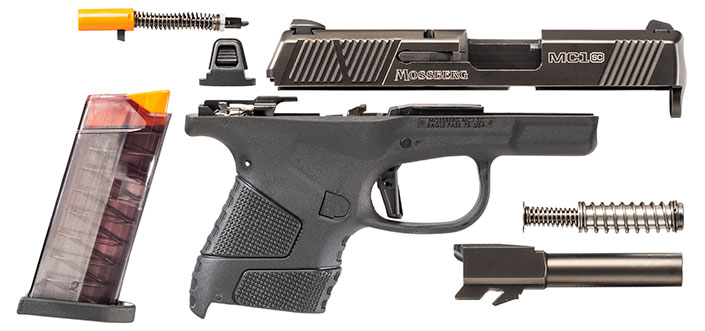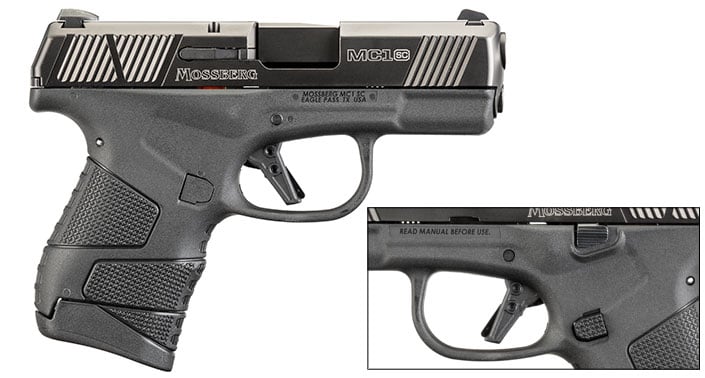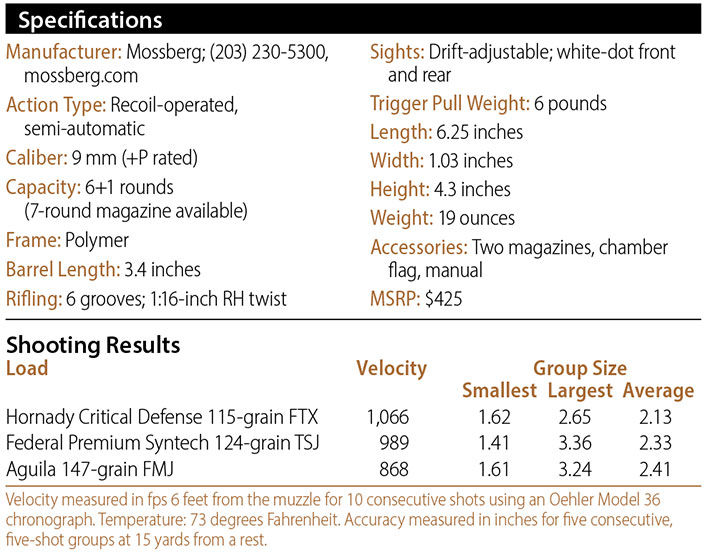By Jay Grazio, Shooting Illustrated
When I was invited to go to Gunsite Academy for a new product launch from Mossberg late last year, my brain immediately sprang into action trying to figure out what the firearm might be. Fresh off the success of the Shockwave and 590M models, I had it in the back of my head that we might be seeing a semi-automatic version of the Shockwave, or perhaps a magazine-fed version of the 930 to complement the 590M.
What I did not expect, in the least, was a single-stack, striker-fired subcompact handgun. But, that’s exactly what was released—Mossberg’s completely new MC1sc pistol. Now, this isn’t Mossberg’s first handgun; that would be the four-barrel Brownie derringer released almost a century ago. It is, however, the company’s first modern handgun, aimed squarely at the hottest-growing segment of the firearm market: concealed carry.
Now, a quick pause. There are those out there already cracking their knuckles in eager anticipation of sending a sternly worded message about how wrong I am. They’ll gleefully point out that Mossberg has had a pistol in its lineup for several years now, referring to the AR-15-style 715P introduced in 2014. Yes. You are technically correct, which we all know is the best kind of correct. However, for the purposes of concealed carry and self-defense, the Mossberg MC1sc represents the company’s first foray into centerfire-caliber, concealable handgun options.
On the first day of the product release, the folks at Mossberg walked us through the market research that went into the development of the MC1sc (Mossberg Carry, subcompact for those that are wondering; the “1” should be easy to figure out). Small pistols designed for easy concealment continue to enjoy robust growth as more and more Americans exercise their enumerated right to keep—and bear—arms. Mossberg even researched popularity by caliber, finding that 9 mm was most popular (sorry, .45 ACP fans), followed by .380 ACP. It was clear that little guns are big business, and that should the company desire to break (back) into the handgun market, it had to think small.

Linda Powell, director of market research for Mossberg, explained in more detail, “Based on marketing research, 44 percent of the firearm market is handgun purchases. Considering the significance of the market share, Mossberg began looking at the specific marketing data related to pistols and the features most highly-desired. With that information in hand, we began the development of the MC1sc in hopes of delivering a superb 9 mm concealed-carry handgun to consumers.”
One complaint one hears whenever a company releases a new firearm centers on aesthetics. Whether the debate hinges on if one finds the firearm in question to be attractive or not, what competitor(s) the gun-of-the-day might be trying to emulate or simply features one thinks the new item should—or shouldn’t—have, aesthetics matter. Even in the group assembled for the launch there was a divide over whether consumers would compare the MC1 to competitor X or Y. There’s a reason these guns tend to look pretty similar, and it has to do far more with the design parameters for the target market than any desire to mimic an extant design.
Mossberg MC1sc Impressions
The Good: Trigger. Of all the things to say about the standard striker-fired, polymer-frame pistols, rarely do you hear “excellent trigger right out of the box” as one of them. If anything, the trigger is described as “heavy,” or “gritty,” or some other adjective attempting to convey that your trigger finger is going to get a workout. Accuracy follows thusly, and is quite dependent on the skill level of the user as to whether the pistol with a long, heavy trigger is anything vaguely resembling consistent.
This is most assuredly not the case with the MC1 trigger. Visually, it’s a flat-face design with a finger rest, typically the hallmark of an aftermarket, custom trigger. Pull is somewhere between 5 and 6 pounds, but the general feel is much better, as the take-up is smooth rather than crunchy, the break is clean and the reset is both audible and tactile. I found myself shooting to reset without even thinking about it.

How good is the trigger? Well, at the MC1’s Gunsite Academy launch we were shooting at steel targets the size of the center-chest area of the Option target—at 35 and 50 yards—and making reliable hits. One shooter, albeit an accomplished professional, made five out of six shots at 50 yards with this brand-new,3.4-inch barrel, single-stack, subcompact 9 mm handgun.
That’s how good the trigger is. Your author, who is most assuredly not an accomplished professional shooter, was even able to make a couple hits on steel at 50 yards. This little gun is way more accurate than it has any right to be (based on its size, sight radius, etc.). The “triggernometry” is, quite simply, excellent. The MC1 has the kind of trigger you generally have to pay extra for, and either give yourself a crash course in home gunsmithing or taking it to a professional.

In conjunction with the remarkable trigger, the grip texture and palm swell contribute to shootability. We ran this little pistol through numerous Gunsite drills for three days straight, putting somewhere in the neighborhood of 8,000 rounds through about a dozen and a half guns. None of the group experienced even moderate discomfort during that time, and the closest thing to a complaint being concern that the middle finger of the shooting hand got a little sore under the trigger guard after extended sessions.
Mossberg really did its homework for the engineering of the MC1sc. Takedown of the pistol requires no tools, but more than that does not require a pull of the trigger. After removing the magazine and checking (and double-checking) to make sure the pistol is unloaded, simply lock the slide to the rear. There’s a rear slide plate that has a clearly marked section that is pressed in to allow it to be removed from the back of the slide, at which point the striker mechanism can be removed. All that’s left is to release the slide and ease it off the frame. It’s quite simple, with two areas of note. First, the area on the slide plate is quite narrow and needs to be pressed in quite sharply—this is good, as it prevents inadvertent release of the plate. Second, when sliding the slide off the frame, it helps to invert things, because otherwise the recoil spring has a tendency to fall right out.
One area that folks might look to improve could be the sights. While the standard three-white-dot arrangement has been the default for defensive handguns for a while, they do have their limitations. Some of the shooters at the Gunsite release event took to blacking out the rear dots, leaving a plain-black rear sight and a white-dot front, which allows more focus on the front blade. The good news here is the Mossberg MC1sc is compatible with SIG-style sights, with both front and rear assemblies dovetailed for simple removal and replacement.
This is Mossberg’s second handgun, and the first in the modern era. For a company well-known for shotguns and rifles, its first new handgun design in literally 100 years being a dedicated self-defense model is surprising and smart. This is a market segment that continues to grow year after year, and establishing Mossberg as a player in the self-defense arena will help it expand its product line for the future.

Running The Mossberg MC1sc
At the MC1sc’s launch at Gunsite, we spent multiple days running drills—drills ostensibly designed for full-size handguns—using the MC1sc. Mossberg’s subtle grip design kept fatigue to a minimum, despite hundreds of rounds sent downrange, and the trigger on the MC1sc deserves plenty of praise. It really is that good; it’s the sort of trigger you’d expect to upgrade to, but in the entry-level variant. With nearly two dozen shooters running as many pistols, I cannot recall a single failure from my pistol, and don’t remember any of the other writers or editors having problems (and this is one picky group).
But, really, the written word doesn’t convey the full extent of the experience: go out and shoot one. You’ll understand the MC1sc much better, at that point. In fact, it relates to an interesting moment at the MC1sc’s release. In a room full of seasoned gunwriters and editors, the folks at Mossberg were a little perplexed at the muted reaction to the MC1sc at first. They were somewhat concerned there wasn’t more buzz about the pistol, when finally one of the writers kinda shrugged and related that, yes, it’s neat, but it’s another single-stack, polymer-frame, striker-fired 9 mm pistol. We’ve seen a bunch of ’em. After three days in the Arizona sun, though, we were impressed. Solid reliability, excellent accuracy and stellar ergonomics had virtually everyone a believer. I’ve had a chance to run a few hundred rounds through the pistol Mossberg sent to NRA HQ with similar results. Bottom line? If you’re looking for a subcompact 9 mm pistol, there’s a lot going right for the new MC1sc. Mossberg’s re-entry in the concealable-handgun market is poised for success, and offers another solid choice for those looking for a self-defense pistol.




